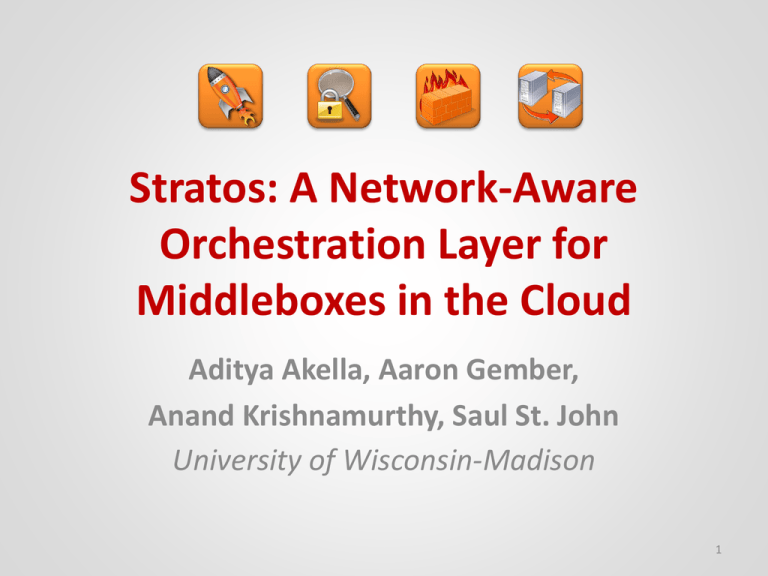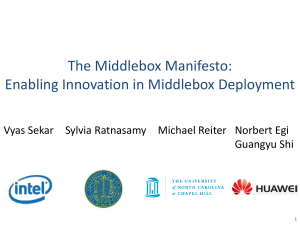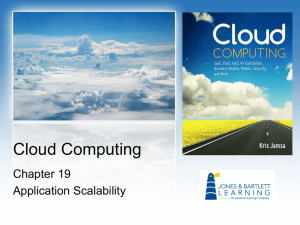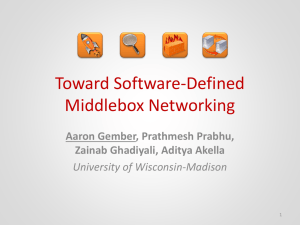Slides - University of Wisconsin
advertisement

Stratos: A Network-Aware Orchestration Layer for Middleboxes in the Cloud Aditya Akella, Aaron Gember, Anand Krishnamurthy, Saul St. John University of Wisconsin-Madison 1 Today’s cloud offerings • Compute and storage are first-class entities – Rich management interfaces – Easy elasticity • What about network services (middleboxes)? Limited cloud-provided middleboxes Third party virtual middlebox images [Sherry et al., SIGCOMM 2012] 2 Insufficient support for middleboxes • Difficult to deploy complex functionality • Difficult to manage • Difficult to cost-effectively scale VM App VM B App VM B VM VM App VM A 3 Stratos Network-aware orchestration layer for middleboxes in clouds • • • • • • Elevates network services to a first-class entity Exports a logical view (middlebox chains) to tenants Performs application-specific, network-aware scaling Minimizes network effects => ↑ utilization and ↓ cost Requires no knowledge of/changes to middleboxes Driven completely by software (leverages SDN) Key to Stratos: network awareness 4 Why network awareness – I • Scale based on resource consumption Rack A Congested link Rack B App Request backlog Low CPU Usage • Ignoring the network insufficient scaling 5 Why network awareness – II • Place VMs without regard to the network App Request backlog Scaling doesn’t help • Ignoring the network ineffective scaling 6 Why network awareness – III • Equally divide traffic among middleboxes 1/2 of traffic traverses inter-rack link Rack A Rack B • Ignoring network over-utilized network • Network bottlenecks spurious scaling 7 Stratos architecture A Stratos Controller B Scaling VM Manager 470 360 730 250 680 100 Software SDN Switches Placement Flow Distribution 8 Stratos scaling • Based on end-to-end application performance – Implicitly compute- and network- aware • Occurs at the granularity of chains • Triggers – Scale up: ↑ chain-traversal latency OR existence of unserved demand – Scale down: ↓ request throughput AND ≈ constant chain-traversal latency 9 Stratos scaling (single chain) • Scaling trials on a chain If ↓ Latency OR ↓ demand backlog: Keep and try another Else: Discard and move on • Fallback: scale all • Also supports scale down and multiple chains App Server 500 ms 400 395 10 Stratos architecture A Stratos Controller B Scaling VM Manager 470 360 730 250 680 100 Software SDN Switches Placement Flow Distribution 11 Scaled instance placement A B If space with input/output VMs: Co-locate in same rack Else Foreach rack i bwci = b/w consumed if use rack i Pick rack with min bwci B A 13 Stratos architecture A Stratos Controller B Scaling VM Manager 470 360 730 250 680 100 Software SDN Switches Placement Flow Distribution 14 Network-aware flow distribution • Goal: minimize network effects Rack A 1/ of traffic (instead of 1/2) 6 Rack B Linear Program Input: tenant chain, incoming traffic volume, traffic ratios, placement Minimize: overall “cost” (aggregate traffic traversing inter-rack links) Subject to: ≈ equal load; coverage • Triggers – Scaling (tenant-specific) – Periodically (all tenants) 15 Implementation domU eth0 Open vSwitch Stratos Controller Floodlight dom0 Xen 16 Implementation – tagging • Controller assigns tags to each flow – Tag identifies path through specific instances – Weighted round-robin assignment of tags to flows • Packets tagged (use DSCP bits) at ingress switch • “Interior” switches forward based on tag App Open vSwitch Tag Packets Open vSwitch Open vSwitch Open vSwitch Forward based on tag 17 Evaluation: Placement & Distribution Spurious scaling Unmet demand Spurious scaling (not pronounced) Unmet demand 18 Evaluation: Scaling A Scaling/Placement/Distribution Aware – ours Aware – ours Aware – ours Thresh - CPU Rand - random Uni - uniform Unmet demand 2X fewer 19 Stratos Summary Network-aware orchestration layer for middleboxes in clouds • • • • Makes middleboxes first-class citizens Minimizes network interactions Maximizes efficiency for tenants and providers Driven by software-defined networking 20







